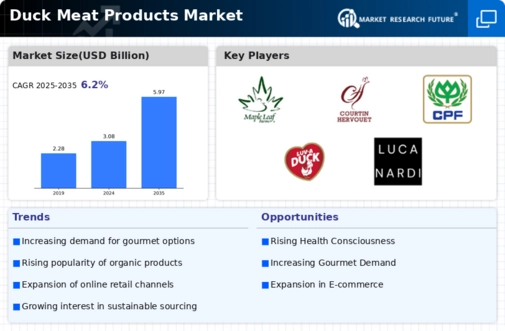Top Industry Leaders in the Duck Meat Products Market

Strategies Adopted by Duck Meat Products Key Players
Global duck meat products market has witnessed significant growth, driven by changing consumer preferences, increasing health consciousness, and a growing demand for poultry products. This landscape is characterized by the presence of several key players, emerging companies, and a continuous evolution in strategies and market dynamics.
List of Key Players
- AJC International, Inc. (US)
- Delpeyrat SAS (France)
- Maple Leaf Farms, Inc. (US)
- Pepe's ducks ltd (Austalia)
- Shandong New Hope Liuhe Group Ltd. (China)
- Courtin Hervouet (France)
- COOPERATIVE FOIE GRAS DE CHALOSSE (France)
- Charoen Pokphand Foods (Thailand)
- TCH Group (US)
- Luv-a-Duck (Australia)
- Lu Canard (Mexico)
- Ferme Uhartia (France)
The key players in the duck meat market have adopted various strategies to maintain and grow their market share. These include product innovation, mergers and acquisitions, expansion into new markets, and sustainability initiatives. For instance, companies are increasingly focusing on organic and free-range duck products to cater to health-conscious consumers.
Market Share Analysis
Market share analysis is influenced by several factors:
Product Quality and Variety: Companies offering a wide range of high-quality products tend to dominate the market.
Brand Recognition: Well-established brands with strong marketing strategies often hold a larger market share.
Distribution Networks: Extensive and efficient distribution networks are crucial for market penetration.
Price Competitiveness: Competitive pricing strategies can attract a larger customer base.
Innovation: Continuous product innovation helps in keeping up with changing consumer preferences.
New and Emerging Companies
Several new and emerging companies are challenging the established players by focusing on niche markets and innovative products. These companies are often more agile and adapt quickly to market trends, such as the increasing demand for organic and free-range duck meats.
Industry News and Current Company Dynamics
The industry has seen various strategic moves and partnerships. For example, there has been an increase in collaborations between Western and Asian companies to leverage distribution networks and local market knowledge. Additionally, technological advancements in processing and packaging have been crucial in expanding the shelf life and quality of duck meat products.
Investment Trends
Investment in the duck meat market is growing, with a focus on sustainable farming practices, technological advancements in processing, and expansion in emerging markets. Private equity and venture capital investments are particularly interested in companies that show potential for international expansion and those that adopt innovative and sustainable practices.
Competitive Scenario
The overall competitive scenario is moderately concentrated, with major players holding significant market shares. HoweverThe presence of numerous small and medium-sized enterprises adds a degree of competition. The market is also witnessing a gradual shift towards more sustainable and ethical farming practices, which is influencing the competitive dynamics.
Recent Developments
The duck meat market has seen several notable developments:
Technological Advancements: There has been a significant investment in technology to improve the quality and safety of duck meat products. Innovations in processing and packaging technologies are prominent.
Expansion in Emerging Markets: Companies are increasingly focusing on expanding their presence in emerging markets, especially in Asia and Africa, where poultry consumption is on the rise.
Mergers and Acquisitions: The year witnessed some strategic mergers and acquisitions as companies aimed to consolidate their market positions and expand their product portfolios.
Sustainability Initiatives: There is a growing trend of adopting sustainable and ethical farming practices. Key players are investing in research and development to improve animal welfare and reduce environmental impact.
COVID-19 Impact and Recovery: The industry is still navigating the challenges posed by the COVID-19 pandemic, with a focus on supply chain resilience and adapting to the changing consumer behaviors resulting from the pandemic.


